Chandra Khatri
IndicVisionBench: Benchmarking Cultural and Multilingual Understanding in VLMs
Nov 06, 2025Abstract:Vision-language models (VLMs) have demonstrated impressive generalization across multimodal tasks, yet most evaluation benchmarks remain Western-centric, leaving open questions about their performance in culturally diverse and multilingual settings. To address this gap, we introduce IndicVisionBench, the first large-scale benchmark centered on the Indian subcontinent. Covering English and 10 Indian languages, our benchmark spans 3 multimodal tasks, including Optical Character Recognition (OCR), Multimodal Machine Translation (MMT), and Visual Question Answering (VQA), covering 6 kinds of question types. Our final benchmark consists of a total of ~5K images and 37K+ QA pairs across 13 culturally grounded topics. In addition, we release a paired parallel corpus of annotations across 10 Indic languages, creating a unique resource for analyzing cultural and linguistic biases in VLMs. We evaluate a broad spectrum of 8 models, from proprietary closed-source systems to open-weights medium and large-scale models. Our experiments reveal substantial performance gaps, underscoring the limitations of current VLMs in culturally diverse contexts. By centering cultural diversity and multilinguality, IndicVisionBench establishes a reproducible evaluation framework that paves the way for more inclusive multimodal research.
VoiceAgentBench: Are Voice Assistants ready for agentic tasks?
Oct 09, 2025

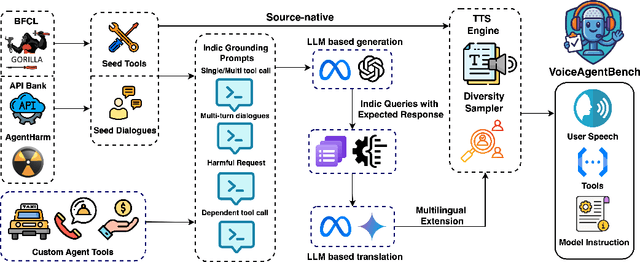
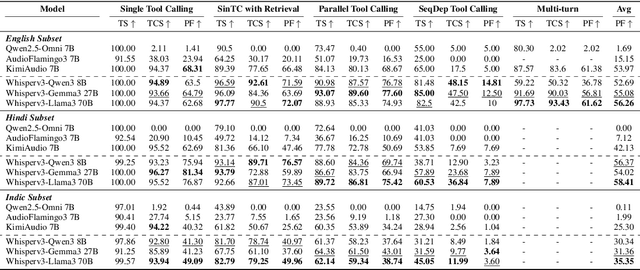
Abstract:Large-scale Speech Language Models (SpeechLMs) have enabled voice assistants capable of understanding natural spoken queries and performing complex tasks. However, existing speech benchmarks primarily focus on isolated capabilities such as transcription, or question-answering, and do not systematically evaluate agentic scenarios encompassing multilingual and cultural understanding, as well as adversarial robustness. To address this, we introduce VoiceAgentBench, a comprehensive benchmark designed to evaluate SpeechLMs in realistic spoken agentic settings. It comprises over 5,500 synthetic spoken queries, including dialogues grounded in Indian context, covering single-tool invocations, multi-tool workflows, multi-turn interactions, and safety evaluations. The benchmark supports English, Hindi, and 5 other Indian languages, reflecting real-world linguistic and cultural diversity. We simulate speaker variability using a novel sampling algorithm that selects audios for TTS voice conversion based on its speaker embeddings, maximizing acoustic and speaker diversity. Our evaluation measures tool selection accuracy, structural consistency, and the correctness of tool invocations, including adversarial robustness. Our experiments reveal significant gaps in contextual tool orchestration tasks, Indic generalization, and adversarial robustness, exposing critical limitations of current SpeechLMs.
Pragyaan: Designing and Curating High-Quality Cultural Post-Training Datasets for Indian Languages
Oct 08, 2025Abstract:The effectiveness of Large Language Models (LLMs) depends heavily on the availability of high-quality post-training data, particularly instruction-tuning and preference-based examples. Existing open-source datasets, however, often lack multilingual coverage, cultural grounding, and suffer from task diversity gaps that are especially pronounced for Indian languages. We introduce a human-in-the-loop pipeline that combines translations with synthetic expansion to produce reliable and diverse Indic post-training data. Using this pipeline, we curate two datasets: Pragyaan-IT (22.5K) and Pragyaan-Align (100K) across 10 Indian languages covering 13 broad and 56 sub-categories, leveraging 57 diverse datasets. Our dataset protocol incorporates several often-overlooked dimensions and emphasize task diversity, multi-turn dialogue, instruction fidelity, safety alignment, and preservation of cultural nuance, providing a foundation for more inclusive and effective multilingual LLMs.
Chitranuvad: Adapting Multi-Lingual LLMs for Multimodal Translation
Feb 27, 2025Abstract:In this work, we provide the system description of our submission as part of the English to Lowres Multimodal Translation Task at the Workshop on Asian Translation (WAT2024). We introduce Chitranuvad, a multimodal model that effectively integrates Multilingual LLM and a vision module for Multimodal Translation. Our method uses a ViT image encoder to extract visual representations as visual token embeddings which are projected to the LLM space by an adapter layer and generates translation in an autoregressive fashion. We participated in all the three tracks (Image Captioning, Text only and Multimodal translation tasks) for Indic languages (ie. English translation to Hindi, Bengali and Malyalam) and achieved SOTA results for Hindi in all of them on the Challenge set while remaining competitive for the other languages in the shared task.
Chitrarth: Bridging Vision and Language for a Billion People
Feb 21, 2025Abstract:Recent multimodal foundation models are primarily trained on English or high resource European language data, which hinders their applicability to other medium and low-resource languages. To address this limitation, we introduce Chitrarth (Chitra: Image; Artha: Meaning), an inclusive Vision-Language Model (VLM), specifically targeting the rich linguistic diversity and visual reasoning across 10 prominent Indian languages. Our model effectively integrates a state-of-the-art (SOTA) multilingual Large Language Model (LLM) with a vision module, primarily trained on multilingual image-text data. Furthermore, we also introduce BharatBench, a comprehensive framework for evaluating VLMs across various Indian languages, ultimately contributing to more diverse and effective AI systems. Our model achieves SOTA results for benchmarks across low resource languages while retaining its efficiency in English. Through our research, we aim to set new benchmarks in multilingual-multimodal capabilities, offering substantial improvements over existing models and establishing a foundation to facilitate future advancements in this arena.
KULCQ: An Unsupervised Keyword-based Utterance Level Clustering Quality Metric
Nov 15, 2024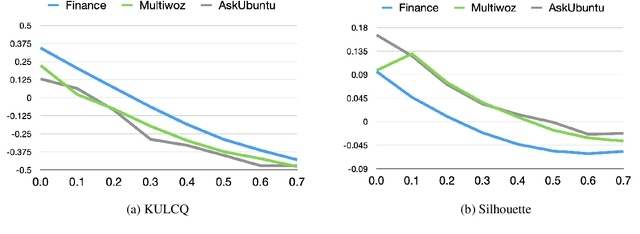


Abstract:Intent discovery is crucial for both building new conversational agents and improving existing ones. While several approaches have been proposed for intent discovery, most rely on clustering to group similar utterances together. Traditional evaluation of these utterance clusters requires intent labels for each utterance, limiting scalability. Although some clustering quality metrics exist that do not require labeled data, they focus solely on cluster geometry while ignoring the linguistic nuances present in conversational transcripts. In this paper, we introduce Keyword-based Utterance Level Clustering Quality (KULCQ), an unsupervised metric that leverages keyword analysis to evaluate clustering quality. We demonstrate KULCQ's effectiveness by comparing it with existing unsupervised clustering metrics and validate its performance through comprehensive ablation studies. Our results show that KULCQ better captures semantic relationships in conversational data while maintaining consistency with geometric clustering principles.
Towards Automatic Evaluation of Task-Oriented Dialogue Flows
Nov 15, 2024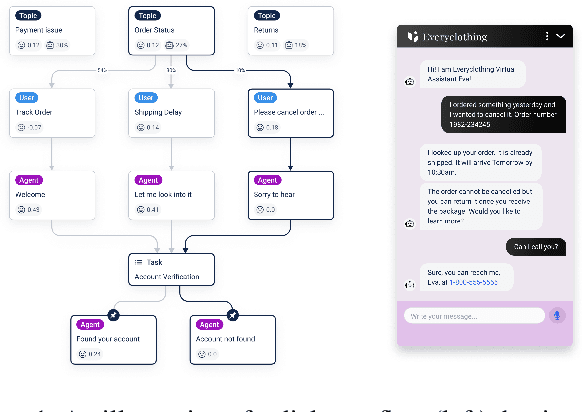
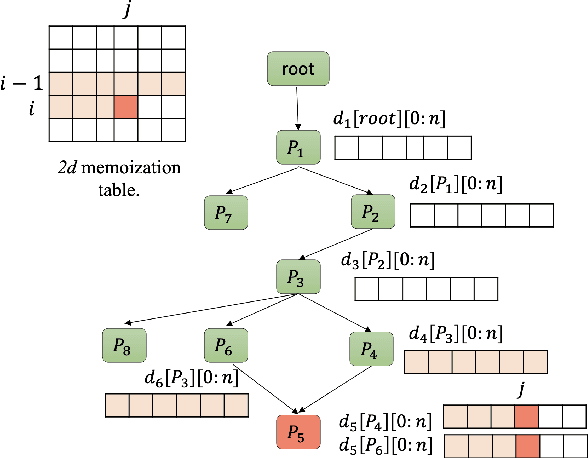

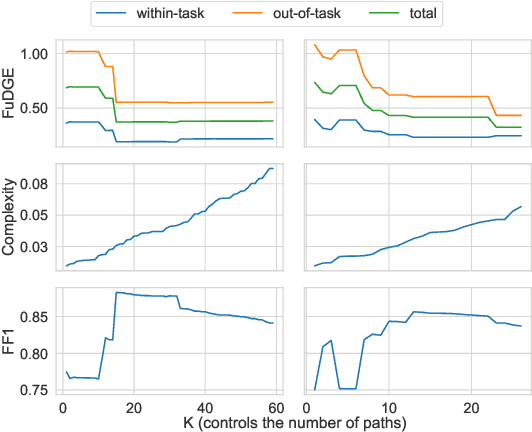
Abstract:Task-oriented dialogue systems rely on predefined conversation schemes (dialogue flows) often represented as directed acyclic graphs. These flows can be manually designed or automatically generated from previously recorded conversations. Due to variations in domain expertise or reliance on different sets of prior conversations, these dialogue flows can manifest in significantly different graph structures. Despite their importance, there is no standard method for evaluating the quality of dialogue flows. We introduce FuDGE (Fuzzy Dialogue-Graph Edit Distance), a novel metric that evaluates dialogue flows by assessing their structural complexity and representational coverage of the conversation data. FuDGE measures how well individual conversations align with a flow and, consequently, how well a set of conversations is represented by the flow overall. Through extensive experiments on manually configured flows and flows generated by automated techniques, we demonstrate the effectiveness of FuDGE and its evaluation framework. By standardizing and optimizing dialogue flows, FuDGE enables conversational designers and automated techniques to achieve higher levels of efficiency and automation.
Joint Contextual Modeling for ASR Correction and Language Understanding
Jan 28, 2020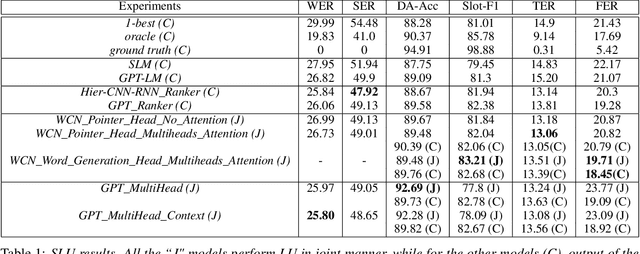
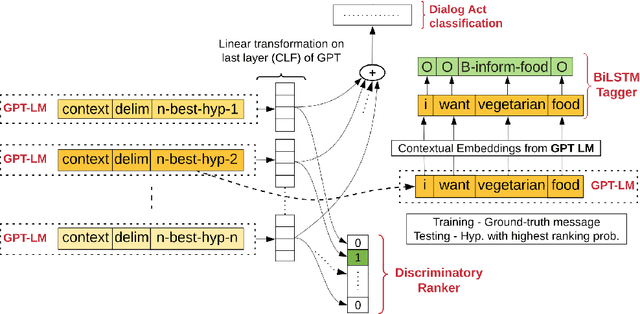
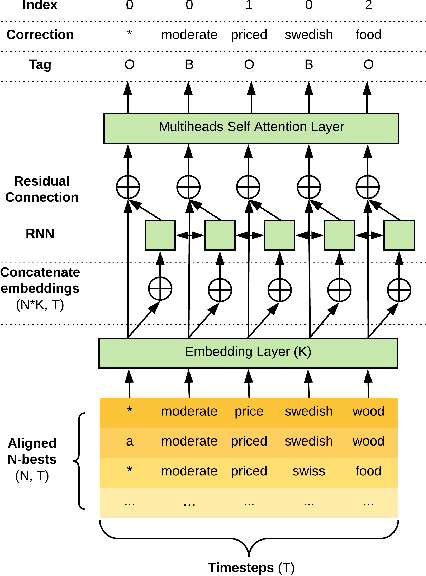
Abstract:The quality of automatic speech recognition (ASR) is critical to Dialogue Systems as ASR errors propagate to and directly impact downstream tasks such as language understanding (LU). In this paper, we propose multi-task neural approaches to perform contextual language correction on ASR outputs jointly with LU to improve the performance of both tasks simultaneously. To measure the effectiveness of this approach we used a public benchmark, the 2nd Dialogue State Tracking (DSTC2) corpus. As a baseline approach, we trained task-specific Statistical Language Models (SLM) and fine-tuned state-of-the-art Generalized Pre-training (GPT) Language Model to re-rank the n-best ASR hypotheses, followed by a model to identify the dialog act and slots. i) We further trained ranker models using GPT and Hierarchical CNN-RNN models with discriminatory losses to detect the best output given n-best hypotheses. We extended these ranker models to first select the best ASR output and then identify the dialogue act and slots in an end to end fashion. ii) We also proposed a novel joint ASR error correction and LU model, a word confusion pointer network (WCN-Ptr) with multi-head self-attention on top, which consumes the word confusions populated from the n-best. We show that the error rates of off the shelf ASR and following LU systems can be reduced significantly by 14% relative with joint models trained using small amounts of in-domain data.
Exploration Based Language Learning for Text-Based Games
Jan 24, 2020


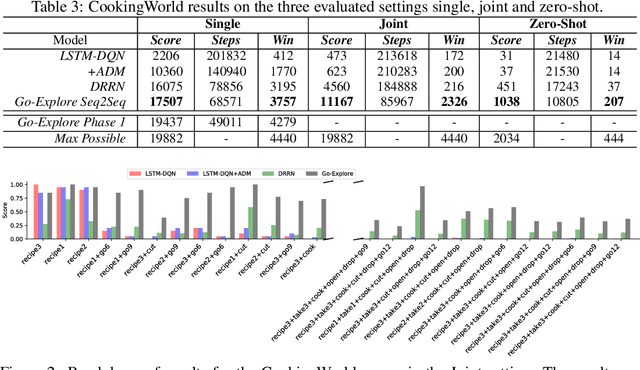
Abstract:This work presents an exploration and imitation-learning-based agent capable of state-of-the-art performance in playing text-based computer games. Text-based computer games describe their world to the player through natural language and expect the player to interact with the game using text. These games are of interest as they can be seen as a testbed for language understanding, problem-solving, and language generation by artificial agents. Moreover, they provide a learning environment in which these skills can be acquired through interactions with an environment rather than using fixed corpora. One aspect that makes these games particularly challenging for learning agents is the combinatorially large action space. Existing methods for solving text-based games are limited to games that are either very simple or have an action space restricted to a predetermined set of admissible actions. In this work, we propose to use the exploration approach of Go-Explore for solving text-based games. More specifically, in an initial exploration phase, we first extract trajectories with high rewards, after which we train a policy to solve the game by imitating these trajectories. Our experiments show that this approach outperforms existing solutions in solving text-based games, and it is more sample efficient in terms of the number of interactions with the environment. Moreover, we show that the learned policy can generalize better than existing solutions to unseen games without using any restriction on the action space.
Plato Dialogue System: A Flexible Conversational AI Research Platform
Jan 17, 2020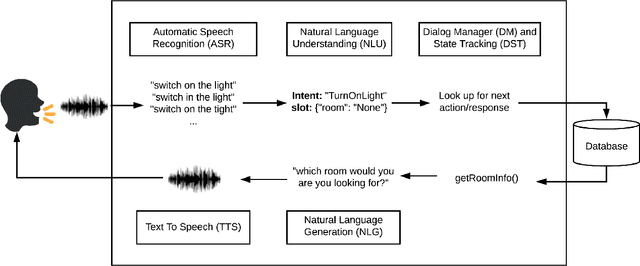
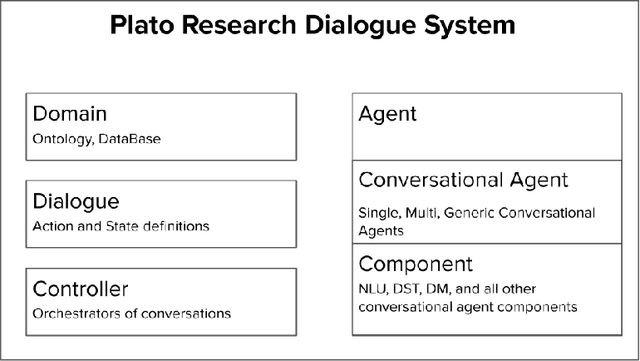
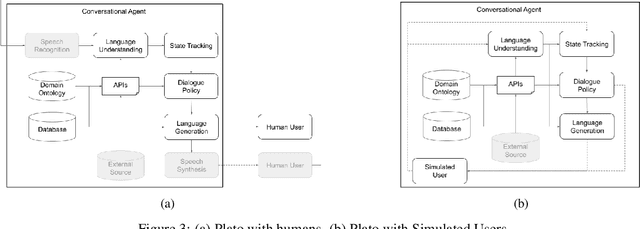
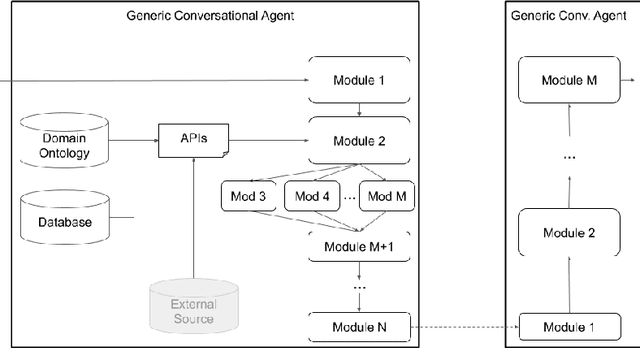
Abstract:As the field of Spoken Dialogue Systems and Conversational AI grows, so does the need for tools and environments that abstract away implementation details in order to expedite the development process, lower the barrier of entry to the field, and offer a common test-bed for new ideas. In this paper, we present Plato, a flexible Conversational AI platform written in Python that supports any kind of conversational agent architecture, from standard architectures to architectures with jointly-trained components, single- or multi-party interactions, and offline or online training of any conversational agent component. Plato has been designed to be easy to understand and debug and is agnostic to the underlying learning frameworks that train each component.
 Add to Chrome
Add to Chrome Add to Firefox
Add to Firefox Add to Edge
Add to Edge